Chromatographic Methods for the Determination of Glyphosate in Cereals Together with a Discussion of Its Occurrence, Accumulation, Fate, Degradation, and Regulatory Status
Abstract
:1. Introduction
2. Glyphosate Degradation Pathways
3. Occurrence Data, Accumulation, and Fate
3.1. Glyphosate Concentration in Straight-Grade Flour vs. Concentration in Wholemeal Flour
3.2. Glyphosate Accumulation in Crops
3.3. Fate and Degradation of Glyphosate
4. Regulatory Status
5. Chemical Analytical Methods
5.1. Liquid Chromatography
5.1.1. FMOC Derivatization
5.1.2. Sample Preparation Used with FMOC Derivatization
5.1.3. Advantages of Indirect Determination
5.1.4. Direct Determination
5.1.5. Glyphosate and Glufosinate
5.2. Gas Chromatography
5.2.1. Sample Preparation and Perfluoroalcohol/TFAA Derivatization
5.2.2. Instrumental Setup
5.2.3. Alkylsilyl Derivatization
5.3. High-Resolution Mass Spectrometry
- (a)
- Simplifying sample preparation. Complex matrices may have interfering ion fragments with masses equal to those of the target analyte when measured at low resolution (unit resolution) and with the same chromatographic retention time. These are so-called isobaric interferences [135]. With low-resolution instruments (triple quadrupoles, ion traps), thorough purification of the sample is required to avoid this drawback. With high-resolution instruments, there is no such problem because the exact mass of the target analyte is monitored.
- (b)
- Chromatographic runtimes. It is possible to shorten the chromatographic runs since possible coelutions of isobaric peaks do not lead to any inaccuracy if the exact mass is monitored. An extension of this approach is the Flow Injection technique, whose main feature is the injection of the predefined sample volume directly to the MS source, with no chromatographic separation [135].
6. Conclusions
Author Contributions
Funding
Conflicts of Interest
References
- Simonetti, E.; Cartaud, G.; Quinn, R.M.; Marotti, I.; Dinelli, G. An Interlaboratory Comparative Study on the Quantitative Determination of Glyphosate at Low Levels in Wheat Flour. J. AOAC Int. 2015, 98, 1760–1768. [Google Scholar] [CrossRef] [PubMed]
- Benbrook, M. Trends in glyphosate herbicide use in the United States and globally. Environ. Sci. Eur. 2016, 28, 3. [Google Scholar] [CrossRef] [PubMed]
- Rigobello-Masini, M.; Oliveira Pereira, E.A.; Abate, G.; Masini, J.C. Solid-Phase Extraction of Glyphosate in the Analyses of Environmental, Plant, and Food Samples. Chromatographia 2019, 82, 1121–1138. [Google Scholar] [CrossRef]
- Gélinas, P.; Gagnon, F.; McKinnon, C. Wheat preharvest herbicide application, whole-grain flour properties, yeast activity and the degradation of glyphosate in bread. Int. J. Food Sci. Technol. 2018, 53, 1597–1602. [Google Scholar] [CrossRef]
- Kadžienė, G.; Pranaitienė, S.; Auškalnienė, O.; Veršulienė, A.; Supronienė, S.; Žvirdauskienė, R.; Gecaitė, V.; Cesevičienė, J.; Semaškienė, R. Oilseed Rape, Wheat, and Barley Grain Contamination as Affected by Different Glyphosate Usage. Plants 2023, 12, 1335. [Google Scholar] [CrossRef] [PubMed]
- Winters, J.F.M.; Foldager, L.; Krogh, U.; Nørskov, N.P.; Sørensen, M.T. Impact of glyphosate residues in sow diets on neonatal piglets: Tail kinks, stillborn and diarrhoea. Livest. Sci. 2023, 269, 105172. [Google Scholar] [CrossRef]
- Andert, S.; de Mol, F.; Koning, L.; Gerowitt, B. Weed response in winter wheat fields on a gradient of glyphosate use in the recent past. Agric. Ecosyst. Environ. 2022, 333, 107977. [Google Scholar] [CrossRef]
- Malalgoda, M.; Ohm, J.-B.; Howatt, K.A.; Green, A.; Simsek, S. Effects of pre-harvest glyphosate use on protein composition and shikimic acid accumulation in spring wheat. Food Chem. 2020, 332, 127422. [Google Scholar] [CrossRef] [PubMed]
- Alahmed, A.; Simsek, S. Pre-harvest glyphosate application effects on properties of β-glucan from oat groats. J. Cereal Sci. 2020, 96, 103119. [Google Scholar] [CrossRef]
- Malalgoda, M.; Ohm, J.-B.; Howatt, K.A.; Simsek, S. Pre-harvest glyphosate application and effects on wheat starch chemistry: Analysis from application to harvest. J. Food Biochem. 2020, 44, e13330. [Google Scholar] [CrossRef]
- Malalgoda, M.; Ohm, J.-B.; Ransom, J.K.; Howatt, K.; Simsek, S. Effects of Pre-Harvest Glyphosate Application on Spring Wheat Quality Characteristics. Agriculture 2020, 10, 111. [Google Scholar] [CrossRef]
- Steinmann, H.-H. Glyphosate: A Herbicide in Discussion and the Quest for the “Necessary Extent”. Gesunde Pflanz. 2013, 65, 47–56. [Google Scholar] [CrossRef]
- Bøhn, T.; Cuhra, M.; Traavik, T.; Sanden, M.; Fagan, J.; Primicerio, R. Compositional differences in soybeans on the market: Glyphosate accumulates in Roundup Ready GM soybeans. Food Chem. 2014, 153, 207–215. [Google Scholar] [CrossRef] [PubMed]
- Masci, M.; Nevigato, T.; Caproni, R. Glifosato residuo nei cereali: Generalità e aspetti chimico-analitici. Tec. Molit. 2020, 71, 41–55. [Google Scholar]
- Steinrücken, H.C.; Amrhein, N. The herbicide glyphosate is a potent inhibitor of 5-enolpyruvylshikimic acid-3-phosphate synthase. Biochem. Biophys. Res. Commun. 1980, 94, 1207–1212. [Google Scholar] [CrossRef] [PubMed]
- Amrhein, N.; Schab, J.; Steinrücken, H.C. The mode of action of the herbicide glyphosate. Naturwissenschaften 1980, 67, 356–357. [Google Scholar] [CrossRef]
- Schönbrunn, E.; Eschenburg, S.; Shuttleworth, W.A.; Schloss, J.V.; Amrhein, N.; Evans, J.N.S.; Kabsch, W. Interaction of the herbicide glyphosate with its target enzyme 5-enolpyruvylshikimate 3-phosphate synthase in atomic detail. Proc. Natl. Acad. Sci. USA 2001, 98, 1376–1380. [Google Scholar] [CrossRef]
- Pesticide Action Network UK. Glyphosate fact sheet. Pestic. News 1996, 33, 28–29. [Google Scholar]
- Singh, R.; Shukla, A.; Kaur, G.; Girdhar, M.; Malik, T.; Mohan, A. Systemic Analysis of Glyphosate Impact on Environment and Human Health. ACS Omega 2024, 9, 6165–6183. [Google Scholar] [CrossRef] [PubMed]
- Wang, M.; Rivenbark, K.J.; Phillips, T.D. Kinetics of glyphosate and aminomethylphosphonic acid sorption onto montmorillonite clays in soil and their translocation to genetically modified corn. J. Environ. Sci. 2024, 135, 669–680. [Google Scholar] [CrossRef] [PubMed]
- IARC, International Agency for Research on Cancer, World Health Organization. Some Organophosphate Insecticides and Herbicides; IARC Monographs on the Evaluation of Carcinogenic Risks to Humans; IARC: Lion, France, 2017; Volume 112, p. 398. Available online: https://publications.iarc.fr/Book-And-Report-Series/Iarc-Monographs-On-The-Identification-Of-Carcinogenic-Hazards-To-Humans/Some-Organophosphate-Insecticides-And-Herbicides-2017 (accessed on 6 March 2024).
- European Commission. Renewing the approval of the active substance glyphosate in accordance with Regulation (EC) No 1107/2009 of the European Parliament and of the Council concerning the placing of plant protection products on the market, and amending the Annex to Commission Implementing Regulation [EU) No 540/2011. Official Journal of the European Union. 2017, L 333/10–L 333/16. Available online: https://eur-lex.europa.eu/legal-content/EN/TXT/?uri=CELEX%3A32017R2324 (accessed on 6 March 2024).
- Gotti, R.; Fiori, J.; Bosi, S.; Dinelli, G. Field-amplified sample injection and sweeping micellar electrokinetic chromatography in analysis of glyphosate and aminomethylphosphonic acid in wheat. J. Chromatogr. A 2019, 1601, 357–364. [Google Scholar] [CrossRef] [PubMed]
- Commission Implementing Regulation (EU). 2023/2660 of 28 November 2023 renewing the approval of the active substance glyphosate in accordance with Regulation (EC) No 1107/2009 of the European Parliament and of the Council and amending Commission Implementing Regulation (EU) No 540/2011. Official Journal of the European Union. 2023. Available online: https://eur-lex.europa.eu/eli/reg_impl/2023/2660 (accessed on 6 March 2024).
- Álvarez, F.; Arena, M.; Auteri, D.; Binaglia, M.; Castoldi, A.F.; Chiusolo, A.; Crivellente, F.; Egsmose, M.; Fait, G.; Ferilli, F.; et al. Peer review of the pesticide risk assessment of the active substance glyphosate. EFSA J. 2023, 21, 8164. [Google Scholar] [CrossRef]
- Istituto Ramazzini, Italy. Global Glyphosate Study Reveals Glyphosate-Based Herbicides Cause Leukemia in Early Life. 25 October 2023. Available online: https://glyphosatestudy.org/press-release/global-glyphosate-study-reveals-glyphosate-based-herbicides-cause-leukemia-in-early-life/ (accessed on 6 March 2024).
- Mao, Q.; Manservisi, F.; Panzacchi, S.; Mandrioli, D.; Menghetti, I.; Vornoli, A.; Bua, L.; Falcioni, L.; Lesseur, C.; Chen, J.; et al. The Ramazzini Institute 13-week pilot study on glyphosate and Roundup administered at human-equivalent dose to Sprague Dawley rats: Effects on the microbiome. Environ. Health-Glob. 2018, 17, 50. [Google Scholar] [CrossRef] [PubMed]
- Lesseur, C.; Pirrotte, P.; Pathak, K.V.; Manservisi, F.; Mandrioli, D.; Belpoggi, F.; Panzacchi, S.; Li, Q.; Barrett, E.S.; Nguyen, R.H.N.; et al. Maternal urinary levels of glyphosate during pregnancy and anogenital distance in newborns in a US multicenter pregnancy cohort. Environ. Pollut. 2021, 280, 117002. [Google Scholar] [CrossRef] [PubMed]
- Lacroix, R.; Kurrasch, D.M. Glyphosate toxicity: In vivo, in vitro, and epidemiological evidence. Toxicol. Sci. 2023, 192, 131–140. [Google Scholar] [CrossRef]
- Hao, C.; Morse, D.; Morra, F.; Zhao, X.; Yang, P.; Nunn, B. Direct aqueous determination of glyphosate and related compounds by liquid chromatography/tandem mass spectrometry using reversed-phase and weak anion-exchange mixed-mode column. J. Chromatogr. A 2011, 1218, 5638–5643. [Google Scholar] [CrossRef] [PubMed]
- Tongur, T.; Ayranci, E. Investigation of the performance of activated carbon cloth to remove glyphosate, glufosinate, aminomethylphosphonic acid and bialaphos from aqueous solutions by adsorption/electrosorption. Environ. Monit. Assess. 2023, 195, 814. [Google Scholar] [CrossRef] [PubMed]
- Leyva-Morales, J.B.; Cabrera, R.; Bastidas-Bastidas, P.d.J.; Valenzuela-Quintanar, A.I.; Pérez-Camarillo, J.P.; González-Mendoza, V.M.; Perea-Domínguez, X.P.; Márquez-Pacheco, H.; Amillano-Cisneros, J.M.; Badilla-Medina, C.N.; et al. Validation and application of liquid chromatography coupled with tandem mass spectrometry method for the analysis of glyphosate, aminomethylphosphonic acid (AMPA), and glufosinate in soil. Agriculture 2023, 13, 1131. [Google Scholar] [CrossRef]
- Martin, P.J.; He, K.; Blaney, L.; Hobbs, S.R. Advanced liquid chromatography with tandem mass spectrometry method for quantifying glyphosate, glufosinate, and aminomethylphosphonic acid using pre-column derivatization. ACS Es&T Water 2023, 3, 2407–2414. [Google Scholar] [CrossRef] [PubMed]
- Sorokin, A.V.; Kish, L.K. Determination of glyphosate, aminomethylphosphonic acid and glufosinate in tea samples of Russia. Asian J. Chem. 2023, 35, 1069–1073. [Google Scholar] [CrossRef]
- Zhang, Y.; Dang, Y.; Lin, X.; An, K.; Li, J.; Zhang, M. Determination of glyphosate and glufosinate in corn using multi-walled carbon nanotubes followed by ultra high performance liquid chromatography coupled with tandem mass spectrometry. J. Chromatogr. A 2020, 169, 460939. [Google Scholar] [CrossRef] [PubMed]
- Ehling, S.; Reddy, T.M. Analysis of glyphosate and aminomethylphosphonic acid in nutritional ingredients and milk by derivatization with fluorenylmethyloxycarbonyl chloride and liquid chromatography-mass spectrometry. J. Agric. Food Chem. 2015, 63, 10562–10568. [Google Scholar] [CrossRef]
- Rämö, S.; Välimäki, J.; Siimes, K.; Uusi-Kämppä, J. Determination of glyphosate and aminomethylphosphonic acid residues in Finnish soils by ultra-high performance liquid chromatography–tandem mass spectrometry. MethodsX 2023, 11, 102397. [Google Scholar] [CrossRef] [PubMed]
- Małysiak, M.; Kiljanek, T. Method of Glyphosate, AMPA, and Glufosinate Ammonium Determination in Beebread by Liquid Chromatography—Tandem Mass Spectrometry after Molecularly Imprinted Solid-Phase Extraction. Molecules 2022, 27, 5741. [Google Scholar] [CrossRef] [PubMed]
- Gains, K.K.K.; Roland, N.G.K.; Urbain, K.Y.; Ardjouma, D. Determination of the glyphosate content in liquid and dry formulations by HPLC-UV: Pre-column derivation with 9-fluorenylmethyl chloroformate (FMOC). Chromatographia 2022, 85, 655–664. [Google Scholar] [CrossRef]
- Alonso, B.; Griffero, L.; Bentos Pereira, H.; Pareja, L.; Pérez Parada, A. Determination of glyphosate and AMPA in freshwater and soil from agroecosystems by 9-fluorenylmethoxycarbonyl chloride derivatization and liquid chromatography–fluorescence detection and tandem mass spectrometry. MethodsX 2022, 9, 101730. [Google Scholar] [CrossRef] [PubMed]
- Delhomme, O.; Rodrigues, A.; Hernandez, A.; Chimjarn, S.; Bertrand, C.; Bourdat-Deschamps, M.; Fritsch, C.; Pelosi, C.; Nélieu, S.; Millet, M. A method to assess glyphosate, glufosinate and aminomethylphosphonic acid in soil and earthworms. J. Chromatogr. A 2021, 1651, 462339. [Google Scholar] [CrossRef] [PubMed]
- Garba, J.; Samsuri, A.W.; Othman, R.; Hamdani, M.S.A. Simplified method for derivatization of extractable glyphosate and aminomethylphosphonic acid and their determination by high performance liquid chromatography. Environ. Res. Technol. 2018, 1, 19–30. [Google Scholar]
- Junqué, E.; Fernández, P.; Filippi, I.; Grimalt, J.O. Determination of glyphosate and its derivative, aminomethylphosphonic acid, in human urine by gas chromatography coupled to tandem mass spectrometry and isotope pattern deconvolution. J. Chromatogr. Open 2023, 4, 100087. [Google Scholar] [CrossRef]
- Steinborn, A.; Alder, L.; Michalski, B.; Zomer, P.; Bendig, P.; Martinez, S.A.; Mol, H.G.J.; Class, T.J.; Costa Pinheiro, N. Determination of glyphosate levels in breast milk samples from germany by LC-MS/MS and GC-MS/MS. J. Agric. Food Chem. 2016, 64, 1414–1421. [Google Scholar] [CrossRef] [PubMed]
- Yang, Y.; Feng, S.; Hu, Y.; Li, Y.; Wang, H.; Liu, J.; Zhong, H. Determination of glyphosate and aminomethyl phosphonic acid residue in green tea by gas chromatography-mass spectrometry. J. Tea Sci. 2020, 40, 125–132. [Google Scholar]
- De Abreu, A.B.G.; Da Matta, M.H. De R.; Montagner, É. Development and validation of a method of analysis of glyphosate in soy grains. Quim. Nova 2008, 31, 5–9. [Google Scholar] [CrossRef]
- Royer, A.; Beguin, S.; Tabet, J.C.; Hulot, S.; Reding, M.A.; Communal, P.Y. Determination of glyphosate and aminomethylphosphonic acid residues in water by gas chromatography with tandem mass spectrometry after exchange ion resin purification and derivatization. Application on vegetable matrixes. Anal. Chem. 2000, 72, 3826–3832. [Google Scholar] [CrossRef] [PubMed]
- Stajnko, A.; Tratnik, J.S.; Kosjek, T.; Mazej, D.; Jagodic, M.; Eržen, I.; Horvat, M. Seasonal glyphosate and AMPA levels in urine of children and adolescents living in rural regions of Northeastern Slovenia. Environ. Int. 2020, 143, 105985. [Google Scholar] [CrossRef] [PubMed]
- Conrad, A.; Schröter-Kermani, C.; Hoppe, H.W.; Rüther, M.; Pieper, S.; Kolossa-Gehring, M. Glyphosate in German adults—Time trend (2001 to 2015) of human exposure to a widely used herbicide. Int. J. Hyg. Environ. Health 2017, 220, 8–16. [Google Scholar] [CrossRef]
- Kittlaus, S.; Lipinski, J.; Speer, K. New approaches for determination of glyphosate and aminomethylphosphonic acid from different tea samples-prospects and limits of cleanup with molecularly imprinted polymer and titanium dioxide. J. AOAC Int. 2009, 92, 703–714. [Google Scholar] [CrossRef] [PubMed]
- Hu, J.-Y.; Chen, C.-L.; Li, J.-Z. A simple method for the determination of glyphosate residues in soil by capillary gas chromatography with nitrogen phosphorus. J. Anal. Chem. 2008, 63, 371–375. [Google Scholar] [CrossRef]
- Li, S.; Li, P.; Li, X.; Wen, N.; Wang, Y.; Lu, W.; Lin, M.; Lang, Z. In maize, co-expression of GAT and GR79-EPSPS provides high glyphosate resistance, along with low glyphosate residues. aBIOTECH 2023, 4, 277–290. [Google Scholar] [CrossRef] [PubMed]
- Hove-Jensen, B.; Zechel, D.L.; Jochimsen, B. Utilization of Glyphosate as Phosphate Source: Biochemistry and Genetics of Bacterial Carbon-Phosphorus Lyase. Microbiol. Mol. Biol. Rev. 2014, 78, 176–197. [Google Scholar] [CrossRef] [PubMed]
- Aslam, S.; Jing, Y.; Nowak, K.M. Fate of glyphosate and its degradation products AMPA, glycine and sarcosine in an agricultural soil: Implications for environmental risk assessment. J. Hazard. Mater. 2023, 447, 130847. [Google Scholar] [CrossRef] [PubMed]
- Kaczynski, P.; Lozowicka, B.; Wolejko, E.; Iwaniuk, P.; Konecki, R.; Dragowski, W.; Lozowicki, J.; Amanbek, N.; Rusilowska, J.; Pietraszko, A. Complex study of glyphosate and metabolites influence on enzymatic activity and microorganisms association in soil enriched with Pseudomonas fluorescens and sewage sludge. J. Hazard. Mater. 2020, 393, 122443. [Google Scholar] [CrossRef]
- Singh, S.; Kumar, V.; Gill, J.P.K.; Datta, S.; Singh, S.; Dhaka, V.; Kapoor, D.; Wani, A.B.; Dhanjal, D.S.; Kumar, M.; et al. Herbicide Glyphosate: Toxicity and Microbial Degradation. Int. J. Environ. Res. Public Health 2020, 17, 7519. [Google Scholar] [CrossRef] [PubMed]
- Graf, H.G.; Biebl, S.M.; Müller, L.; Breitenstein, C.; Huhn, C. Capillary electrophoresis applied for the determination of acidity constants and limiting electrophoretic mobilities of ionizable herbicides including glyphosate and its metabolites and for their simultaneous separation. J. Sep. Sci. 2022, 45, 1128–1139. [Google Scholar] [CrossRef] [PubMed]
- Simonsen, L.; Fomsgaard, I.S.; Svensmark, B.; Spliid, N.H. Fate and availability of glyphosate and AMPA in agricultural soil. J. Environ. Sci. Health B 2008, 43, 365–375. [Google Scholar] [CrossRef] [PubMed]
- Martins-Gomes, C.; Silva, T.L.; Andreani, T.; Silva, A.M. Glyphosate vs. Glyphosate-Based Herbicides Exposure: A Review on Their Toxicity. J. Xenobiot. 2022, 12, 21–40. [Google Scholar] [CrossRef] [PubMed]
- Santos Barreto, L.; Lima de Souza, T.; Pereira de Morais, T.; De Oliveira Ribeiro, C.A. Toxicity of glyphosate and aminomethylphosphonic acid (AMPA) to the early stages of development of Steindachneridion melanodermatum, an endangered endemic species of Southern Brazil. Environ. Toxicol. Pharmacol. 2023, 102, 104234. [Google Scholar] [CrossRef]
- Granby, K.; Johannesen, S.; Vahl, M. Analysis of glyphosate residues in cereals using liquid chromatography-mass spectrometry (LC-MS/MS). Food Addit. Contam. 2003, 20, 692–698. [Google Scholar] [CrossRef] [PubMed]
- Zoller, O.; Rhyn, P.; Rupp, H.; Zarn, J.A.; Geiser, C. Glyphosate residues in Swiss market foods: Monitoring and risk evaluation. Food Addit. Contam. B 2018, 11, 83–91. [Google Scholar] [CrossRef] [PubMed]
- Rodrigues, N.R.; Ferreira de Souza, A.P.; Morais, P.P.P.; Braga, D.P.V.; Crivellari, A.C.; Favoretto, L.R.G.; Berger, G.U. Residues of glyphosate and aminomethylphosphonic acid (AMPA) in genetically modified glyphosate tolerant soybean, corn and cotton crops. Ciência Rural. 2021, 51, e20190244. [Google Scholar] [CrossRef]
- Bou-Mitri, C.; Mekanna, A.N.; Dagher, S.; Moukarzel, S.; Farhat, A. Occurrence and exposure to glyphosate present in bread and flour products in Lebanon. Food Control 2022, 136, 108894. [Google Scholar] [CrossRef]
- Rodrigues, N.R.; Ferreira de Souza, A.P. Occurrence of glyphosate and AMPA residues in soy-based infant formula sold in Brazil. Food Addit. Contam. A 2018, 35, 723–730. [Google Scholar] [CrossRef] [PubMed]
- Arregui, M.C.; Leonardón, A.; Sanchez, D.; Maitre, M.I.; Scotta, R.; Enrique, S. Monitoring glyphosate residues in transgenic glyphosate-resistant soybean. Pest Manag. Sci. 2004, 60, 163–166. [Google Scholar] [CrossRef] [PubMed]
- Kolakowski, B.M.; Miller, L.; Murray, A.; Leclair, A.; Bietlot, H.; Van de Riet, J.M. Analysis of glyphosate residues in foods from the Canadian retail markets between 2015 and 2017. J. Agric. Food Chem. 2020, 68, 5201–5211. [Google Scholar] [CrossRef] [PubMed]
- Liao, Y.; Berthion, J.-M.; Colet, I.; Merlo, M.; Nougadère, A.; Hu, R. Validation and application of analytical method for glyphosate and glufosinate in foods by liquid chromatography-tandem mass spectrometry. J. Chromatogr. A 2018, 1549, 31–38. [Google Scholar] [CrossRef] [PubMed]
- Soares, D.; Silva, L.; Duarte, S.; Pena, A.; Pereira, A. Glyphosate use, toxicity and occurrence in food. Food 2021, 10, 2785. [Google Scholar] [CrossRef]
- Granby, K.; Vahl, M. Investigation of the herbicide glyphosate and the plant growth regulators chlormequat and mepiquat in cereals produced in Denmark. Food Addit. Contam. 2001, 18, 898–905. [Google Scholar] [CrossRef] [PubMed]
- Xu, J.; Smith, S.; Smith, G.; Wang, W.; Li, Y. Glyphosate contamination in grains and foods: An overview. Food Control 2019, 106, 106710. [Google Scholar] [CrossRef]
- Tittlemier, S.A.; Bestvater, L.; Carlson, J.; Kletke, J.; Izydorczyk, M.; Fu, B.X. Fate of glyphosate in wheat during milling and bread production. Cereal Chem. 2021, 98, 100–108. [Google Scholar] [CrossRef]
- Tittlemier, S.A.; Bestvater, L.; Chan, J.; Timofeiev, V.; Richter, A.; Wang, K.; Ruan, Y.; Izydorczyk, M.; Fu, B.X. Diverging fates of cadmium and glyphosate during pasta cooking. Food Addit. Contam. A 2023, 40, 1459–1469. [Google Scholar] [CrossRef] [PubMed]
- Amvrazi, E.G. Fate of Pesticide Residues on Raw Agricultural Crops after Postharvest Storage and Food Processing to Edible Portions. In Pesticides—Formulations, Effects, Fate; Stoytcheva, M., Ed.; InTech: Rijeka, Croatia, 2011; ISBN 978-953-307-532-7. [Google Scholar] [CrossRef]
- Ashley-Martin, J.; Huang, R.; MacPherson, S.; Brion, O.; Owen, J.; Gaudreau, E.; Bienvenu, J.-F.; Fisher, M.; Borghese, M.M.; Bouchard, M.F.; et al. Urinary concentrations and determinants of glyphosate and glufosinate in pregnant Canadian participants in the MIREC study. Environ. Res. 2023, 217, 114842. [Google Scholar] [CrossRef] [PubMed]
- Mellen, P.B.; Walsh, T.F.; Herrington, D.M. Whole grain intake and cardiovascular disease: A meta-analysis. Nutr. Metab. Cardiovasc. Dis. 2008, 18, 283–290. [Google Scholar] [CrossRef] [PubMed]
- Aune, D.; Norat, T.; Romundstad, P.; Vatten, L.J. Whole grain and refined grain consumption and the risk of type 2 diabetes: A systematic review and dose–response meta-analysis of cohort studies. Eur. J. Epidemiol. 2013, 28, 845–858. [Google Scholar] [CrossRef] [PubMed]
- Slavin, G. Why whole grains are protective: Biological mechanisms. Proc. Nutr. Soc. 2003, 62, 129–134. [Google Scholar] [CrossRef] [PubMed]
- Björck, I.; Östman, E.; Kristensen, M.; Mateo Anson, N.; Price, R.K.; Haenen, G.R.M.M.; Havenaar, R.; Bach Knudsen, K.E.; Frid, A.; Mykkänen, H.; et al. Cereal grains for nutrition and health benefits: Overview of results from in vitro, animal and human studies in the HEALTHGRAIN project. Trends Food Sci. Technol. 2012, 25, 87–100. [Google Scholar] [CrossRef]
- Slavin, J. Whole grains and human health. Nutr. Res. Rev. 2004, 17, 99–110. [Google Scholar] [CrossRef] [PubMed]
- Low, F.L.; Shaw, I.C.; Gerrard, J.A. The effect of Saccharomyces cerevisiae on the stability of the herbicide glyphosate during bread leavening. Lett. Appl. Microbiol. 2005, 40, 133–137. [Google Scholar] [CrossRef]
- Rendón-von Osten, J.; Dzul-Caamal, R. Glyphosate residues in groundwater, drinking water and urine of subsistence farmers from intensive agriculture localities: A survey in Hopelchén, Campeche, Mexico. Int. J. Environ. Res. Public Health 2017, 14, 595. [Google Scholar] [CrossRef] [PubMed]
- Carles, L.; Gardon, H.; Joseph, L.; Sanchís, J.; Farré, M.; Artigas, J. Meta-analysis of glyphosate contamination in surface waters and dissipation by biofilms. Environ. Int. 2019, 124, 284–293. [Google Scholar] [CrossRef] [PubMed]
- Lima, I.B.; Boëchat, I.G.; Fernandes, M.D.; Monteiro, J.A.F.; Rivaroli, L.; Gücker, B. Glyphosate pollution of surface runoff, stream water, and drinking water resources in Southeast Brazil. Environ. Sci. Pollut. Res. 2023, 30, 27030–27040. [Google Scholar] [CrossRef]
- Peruzzo, P.J.; Porta, A.A.; Ronco, A.E. Levels of glyphosate in surface waters, sediments and soils associated with direct sowing soybean cultivation in north pampasic region of Argentina. Environ. Pollut. 2008, 156, 61–66. [Google Scholar] [CrossRef] [PubMed]
- Ruiz-Toledo, J.; Castro, R.; Rivero-Pérez, N.; Bello-Mendoza, R.; Sánchez, D. Occurrence of glyphosate in water bodies derived from intensive agriculture in a tropical region of southern Mexico. Bull. Environ. Contam. Toxicol. 2014, 93, 289–293. [Google Scholar] [CrossRef] [PubMed]
- Ulrich, J.C.; Hoffman, K.; Gunasekara, T.D.K.S.C.; Sandamini, P.M.M.A.; Jackson, B.P.; De Silva, P.; Mangala, C.S.; Jayasundara, N.; Ferguson, P.L. Glyphosate and Fluoride in High-Hardness Drinking Water Are Positively Associated with Chronic Kidney Disease of Unknown Etiology (CKDu) in Sri Lanka. Environ. Sci. Technol. Lett. 2023, 10, 916–923. [Google Scholar] [CrossRef]
- Pires, N.L.; Pereira de Araújo, E.; Oliveira-Filho, E.C.; Dutra Caldas, E. An ultrasensitive LC-MS/MS method for the determination of glyphosate, AMPA and glufosinate in water—Analysis of surface and groundwater from a hydrographic basin in the Midwestern region of Brazil. Sci. Total Environ. 2023, 875, 162499. [Google Scholar] [CrossRef] [PubMed]
- Silva, V.; Montanarella, L.; Jones, A.; Fernández-Ugalde, O.; Mol, H.G.J.; Ritsema, C.J.; Geissen, V. Distribution of glyphosate and aminomethylphosphonic acid (AMPA) in agricultural topsoils of the European Union. Sci. Total Environ. 2018, 621, 1352–1359. [Google Scholar] [CrossRef] [PubMed]
- Thompson, T.S.; van den Heever, J.P.; Limanowka, R.E. Determination of glyphosate, AMPA, and glufosinate in honey by online solid-phase extraction-liquid chromatography-tandem mass spectrometry. Food Addit. Contam. A 2019, 36, 434–446. [Google Scholar] [CrossRef] [PubMed]
- Bento, C.P.M.; Yang, X.; Gort, G.; Xue, S.; Van Dam, R.; Zomer, P.; Mol, H.G.J.; Ritsema, C.J.; Geissen, V. Persistence of glyphosate and aminomethylphosphonic acid in loess soil under different combinations of temperature, soil moisture and light/darkness. Sci. Total Environ. 2016, 572, 301–311. [Google Scholar] [CrossRef]
- Duke, S.O.; Lydon, J.; Koskinen, W.C.; Moorman, T.B.; Chaney, R.L.; Hammerschmidt, R. Glyphosate effects on plant mineral nutrition, crop rhizosphere microbiota, and plant disease in glyphosate-resistant crops. J. Agric. Food Chem. 2012, 60, 10375–10397. [Google Scholar] [CrossRef] [PubMed]
- Regulation (EC) No 396/2005 of the European Parliament and of the Council on maximum residue levels of pesticides in or on food and feed of plant and animal origin and amending Council Directive 91/414/EEC. Official Journal of the European Union. 2023. Available online: https://eur-lex.europa.eu/eli/reg/2005/396/oj (accessed on 11 March 2024).
- European Food Safety Authority (EFSA). Review of the existing maximum residue levels for glyphosate according to Article 12 of Regulation (EC) No 396/2005—Revised version to take into account omitted data. EFSA J. 2019, 17, e05862. [Google Scholar] [CrossRef]
- Food and Agriculture Organization of the United Nations (FAO)/World Health Organization (WHO). Codex Alimentarius, International Food Standards, Glyphosate. Available online: https://www.fao.org/fao-who-codexalimentarius/codex-texts/dbs/pestres/pesticide-detail/en/?p_id=158 (accessed on 11 March 2024).
- United States Environmental Protection Agency (US EPA). Regulation of Pesticide Residues on Food, 40 CFR § 180.364–Glyphosate; Tolerances for Residues. 1 July 2022. Available online: https://www.govinfo.gov/app/details/CFR-2022-title40-vol26/CFR-2022-title40-vol26-sec180-364 (accessed on 11 March 2024).
- Health Canada, Government of Canada, Pesticide Product Information Database. Glyphosate. Available online: https://pest-control.canada.ca/pesticide-registry/en/mrl-search.html (accessed on 11 March 2024).
- Hogendoorn, E.A.; Ossendrijver, F.M.; Dijkman, E.; Baumann, R.A. Rapid determination of glyphosate in cereal samples by means of pre-column derivatisation with 9-fluorenylmethyl chloroformate and coupled-column liquid chromatography with fluorescence detection. J. Chromatogr. A 1999, 833, 67–73. [Google Scholar] [CrossRef] [PubMed]
- Andersen, J.H.; Bille, R.L.L.; Granby, K. An intercomparison study of the determination of glyphosate, chlormequat and mepiquat residues in wheat. Food Addit. Contam. 2007, 24, 140–148. [Google Scholar] [CrossRef]
- Ayoola, R.T.; Olujimi, O.O.; Bada, B.S.; Dedeke, G.A. Seasonal variations in the levels of glyphosate in soil, water and crops from three farm settlements in Oyo state, Nigeria. Heliyon 2023, 9, e20324. [Google Scholar] [CrossRef]
- Sun, L.; Kong, D.; Gu, W.; Guo, X.; Tao, W.; Shan, Z.; Wang, Y.; Wang, N. Determination of glyphosate in soil/sludge by high performance liquid chromatography. J. Chromatogr. A 2017, 1502, 8–13. [Google Scholar] [CrossRef]
- Zhang, W.; Feng, Y.; Ma, L.; An, J.; Zhang, H.; Cao, M.; Zhu, H.; Kang, W.; Lian, K. A method for determining glyphosate and its metabolite aminomethyl phosphonic acid by gas chromatography-flame photometric detection. J. Chromatogr. A 2019, 1589, 116–121. [Google Scholar] [CrossRef] [PubMed]
- Huhn, C. More and enhanced glyphosate analysis is needed. Anal. Bioanal. Chem. 2018, 410, 3041–3045. [Google Scholar] [CrossRef] [PubMed]
- ISO 16308:2014; International Organization for Standardization. Water quality—Determination of Glyphosate and AMPA—Method Using High Performance Liquid Chromatography (HPLC) with Tandem Mass Spectrometric Detection. ISO: Geneva, Switzerland, 2014. Available online: https://www.iso.org/standard/56140.html (accessed on 12 March 2024).
- Cruz, J.M.; Murray, J.A. Determination of glyphosate and AMPA in oat products for the selection of candidate reference materials. Food Chem. 2021, 342, 128213. [Google Scholar] [CrossRef] [PubMed]
- Sancho, J.V.; Hidalgo, C.; Hernández, F.; López, F.J.; Dijkman, E.; Hogendoorn, E.A. Rapid Determination of Glyphosate Residues and Its Main Metabolite Ampa in Soil Samples by Liquid Chromatography. Int. J. Environ. Anal. Chem. 1996, 62, 53–63. [Google Scholar] [CrossRef]
- Piestansky, J.; Olesova, D.; Matuskova, M.; Cizmarova, I.; Chalova, P.; Galba, J.; Majerova, P.; Mikus, P.; Kovac, A. Amino acids in inflammatory bowel diseases: Modern diagnostic tools and methodologies. Adv. Clin. Chem. 2022, 107, 139–213. [Google Scholar] [CrossRef] [PubMed]
- Franke, A.A.; Li, X.; Lai, J.F. Analysis of glyphosate, aminomethylphosphonic acid, and glufosinate from human urine by HRAM LC-MS. Anal. Bioanal. Chem. 2020, 412, 8313–8324. [Google Scholar] [CrossRef] [PubMed]
- Ding, J.; Jin, G.; Shen, A.; Guo, Z.; Yu, B.; Jiao, Y.; Yan, J.; Liang, X. Determination of Underivatized Glyphosate Residues in Plant-Derived Food with Low Matrix Effect by Solid Phase Extraction-Liquid Chromatography-Tandem Mass Spectrometry. Food Anal. Methods 2016, 9, 2856–2863. [Google Scholar] [CrossRef]
- Li, X.; Xu, J.; Jiang, Y.; Chen, L.; Xu, Y.; Pan, C. Hydrophilic-interaction liquid chromatography (HILIC) with dad and mass spectroscopic detection for direct analysis of glyphosate and glufosinate residues and for product quality control. Acta Chromatogr. 2009, 21, 559–576. [Google Scholar] [CrossRef]
- Chiarello, M.; Jiménez-Medina, M.L.; Saéz, J.M.; Moura, S.; Garrido Frenich, A.; Romero-González, R. Fast analysis of glufosinate, glyphosate and its main metabolite, aminomethylphosphonic acid, in edible oils, by liquid chromatography coupled with electrospray tandem mass spectrometry. Food Addit. Contam. A 2019, 36, 1376–1384. [Google Scholar] [CrossRef] [PubMed]
- Zhang, P.; Rose, M.; Van Zwieten, L. Direct determination of glyphosate and its metabolite AMPA in soil using mixed-mode solid-phase purification and LC-MS/MS determination on a hypercarb column. J. AOAC Int. 2019, 102, 952–965. [Google Scholar] [CrossRef] [PubMed]
- Takano, H.K.; Dayan, F.E. Glufosinate-ammonium: A review of the current state of knowledge. Pest Manag. Sci. 2020, 76, 3911–3925. [Google Scholar] [CrossRef] [PubMed]
- Hoerlein, G. Glufosinate (phosphinothricin), a natural amino acid with unexpected herbicidal properties. Rev. Environ. Contam. Toxicol. 1994, 138, 73–145. [Google Scholar] [CrossRef] [PubMed]
- Koskinen, W.C.; Marek, L.J.; Hall, K.E. Analysis of glyphosate and aminomethylphosphonic acid in water, plant materials and soil. Pest Manag. Sci. 2016, 72, 423–432. [Google Scholar] [CrossRef] [PubMed]
- Gauglitz, G.; Wimmer, B.; Melzer, T.; Huhn, C. Glyphosate analysis using sensors and electromigration separation techniques as alternatives to gas or liquid chromatography. Anal. Bioanal. Chem. 2018, 410, 725–746. [Google Scholar] [CrossRef]
- Ding, J.; Guo, H.; Liu, W.-W.; Zhang, W.-W.; Wang, J.-W. Current progress on the detection of glyphosate in environmental samples. J. Sci. Appl. BioMed. 2015, 3, 88–95. [Google Scholar]
- Deyrup, C.L.; Chang, S.M.; Weintraub, R.A.; Moye, H.A. Simultaneous Esterification and Acylation of Pesticides for Analysis by Gas Chromatography. 1. Derivatization of Glyphosate and (Aminomethyl)phosphonic Acid with Fluorinated Alcohols-Perfluorinated Anhydrides. J. Agric. Food Chem. 1985, 33, 944–947. [Google Scholar] [CrossRef]
- Konar, S.K.; Roy, D.N. Method for the determination of residues of the herbicide glyphosate and its principal metabolite, aminomethylphosphonic acid, in plant materials by nitrogen-selective gas chromatography. Anal. Chim. Acta 1990, 229, 277–280. [Google Scholar] [CrossRef]
- Eberbach, P.L.; Douglas, L.A. Method for the Determination of Glyphosate and (Aminomethyl)phosphonic Acid in Soil Using Electron Capture Gas Chromatography. J. Agric. Food Chem. 1991, 39, 1776–1780. [Google Scholar] [CrossRef]
- AOAC INTERNATIONAL, Association of Official Analytical Collaboration International (formerly Association of Official Analytical Chemists). Determination of Glyphosate and Aminomethylphosphonic Acid (AMPA) in Crops. Gas Chromatography with Mass-Selective Detection; First Action 2000; AOAC: Rockville, MD, USA, 2019. [Google Scholar]
- Alferness, P.L.; Wiebe, L.A. Determination of glyphosate and aminomethylphosphonic acid in crops by capillary gas chromatography with mass-selective detection: Collaborative study. J. AOAC Int. 2001, 84, 823–846. [Google Scholar] [CrossRef] [PubMed]
- Alferness, P.L.; Iwata, Y. Determination of Glyphosate and (Aminomethyl)phosphonic Acid in Soil, Plant and Animal Matrixes, and Water by Capillary Gas Chromatography with Mass-Selective Detection. J. Agric. Food Chem. 1994, 42, 2751–2759. [Google Scholar] [CrossRef]
- Börjesson, E.; Torstensson, L. New methods for determination of glyphosate and (aminomethyl)phosphonic acid in water and soil. J. Chromatogr. A 2000, 886, 207–216. [Google Scholar] [CrossRef] [PubMed]
- Hori, Y.; Fujisawa, M.; Shimada, K.; Hirose, Y. Determination of the herbicide glyphosate and its metabolite in biological specimens by gas chromatography-mass spectrometry. A case of poisoning by Roundup® herbicide. J. Anal. Toxicol. 2003, 27, 162–166. [Google Scholar] [CrossRef] [PubMed]
- Motojyuku, M.; Saito, T.; Akieda, K.; Otsuka, H.; Yamamoto, I.; Inokuchi, S. Determination of glyphosate, glyphosate metabolites, and glufosinate in human serum by gas chromatography–mass spectrometry. J. Chromatogr. B 2008, 875, 509–514. [Google Scholar] [CrossRef] [PubMed]
- Aris, A.; Leblanc, S. Maternal and fetal exposure to pesticides associated to genetically modified foods in Eastern Townships of Quebec, Canada. Reprod. Toxicol. 2011, 31, 528–533. [Google Scholar] [CrossRef] [PubMed]
- Saito, T.; Miura, N.; Namera, A.; Oikawa, H.; Miyazaki, S.; Nakamoto, A.; Inokuchi, S. Mixed-mode C–C18 monolithic spin-column extraction and GC–MS for simultaneous assay of organophosphorus compounds, glyphosate, and glufosinate in human serum and urine. Forensic Toxicol. 2012, 30, 1–10. [Google Scholar] [CrossRef]
- Tsunoda, N. Simultaneous determination of the herbicides glyphosate, glufosinate and bialaphos and their metabolites by capillary gas chromatography-ion-trap mass spectrometry. J. Chromatogr. 1993, 637, 167–173. [Google Scholar] [CrossRef]
- Ngim, K.K.; Green, J.; Cuzzi, J.; Ocampo, M.; Gu, Z. Optimized derivatization procedure for characterizing (Aminomethyl) phosphonic acid impurities by GC-MS. J. Chromatogr. Sci. 2011, 49, 8–14. [Google Scholar] [CrossRef]
- Catrinck, T.C.P.G.; Aguiar, M.C.S.; Dias, A.; Silvério, F.O.; Fidêncio, P.H.; Paulino de Pinho, G. Study of the Reaction Derivatization Glyphosate and Aminomethylphosphonic Acid (AMPA) with N,O-Bis(trimethylsilyl)trifluoroacetamide. Am. J. Anal. Chem. 2013, 4, 647–652. [Google Scholar] [CrossRef]
- Arkan, T.; Csámpai, A.; Molnár-Perl, I. Alkylsilyl derivatization of glyphosate and aminomethylphosphonic acid followed by gas chromatography mass spectrometry. Microchem. J. 2016, 125, 219–223. [Google Scholar] [CrossRef]
- Giang, L.T.; Thien, T.L.T.; Yen, D.H. Studying method of underivatized determination glyphosate, glufosinate and their metabolites in drinking water. Vietnam. J. Chem. 2020, 58, 74–79. [Google Scholar] [CrossRef]
- Rajski, Ł.; Díaz Galiano, F.J.; Cutillas, V.; Fernández-Alba, A.R. Coupling ion chromatography to Q-orbitrap for the fast and robust analysis of anionic pesticides in fruits and vegetables. J. AOAC. Int. 2018, 101, 352–359. [Google Scholar] [CrossRef] [PubMed]
- Andjelkovic, D.; Brankovic, M. Flow-injection MS analysis as a simplified approach to pesticide screening in apples. Food Addit. Contam. A 2023, 40, 1011–1024. [Google Scholar] [CrossRef]
- Zubarev, R.A.; Makarov, A. Orbitrap mass spectrometry. Anal. Chem. 2013, 85, 5288–5296. [Google Scholar] [CrossRef] [PubMed]
- Manzano-Sánchez, L.; Martínez-Martínez, J.A.; Domínguez, I.; Martínez Vidal, J.L.; Garrido Frenich, A.; Romero-González, R. Development and application of a novel pluri-residue method to determine polar pesticides in fruits and vegetables through liquid chromatography high resolution mass spectrometry. Foods 2020, 9, 553. [Google Scholar] [CrossRef] [PubMed]
- Han, Y.; Song, L.; Zhao, P.; Li, Y.; Zou, N.; Qin, Y.; Li, X.; Pan, C. Residue determination of glufosinate in plant origin foods using modified Quick Polar Pesticides (QuPPe) method and liquid chromatography coupled with tandem mass spectrometry. Food Chem. 2016, 197, 730–736. [Google Scholar] [CrossRef] [PubMed]
- Anastassiades, M.; Kolberg, D.I.; Eichhorn, E.; Benkenstein, A.; Lukačević, S.; Mack, D.; Wildgrube, C.; Sigalov, I.; Dörk, D.; Barth, A. Quick Method for the Analysis of Numerous Highly Polar Pesticides in Foods of Plant Origin via LC-MS/MS Involving Simultaneous Extraction with Methanol (QuPPe-Method); EU Reference Laboratory for pesticides requiring Single Residue Methods (EURL-SRM)—CVUA: Stuttgart, Germany, 2015; pp. 1–60. [Google Scholar]
- Butovskaya, E.; Gasparini, M.; Angelone, B.; Cancemi, G.; Tranquillo, V.; Prestini, G.; Bosi, F.; Menotta, S. Occurrence of Glyphosate and Other Polar Pesticides in Honey from Lombardy and Emilia-Romagna Regions in Italy: Three-Year Monitoring Results. Foods 2023, 12, 4448. [Google Scholar] [CrossRef] [PubMed]


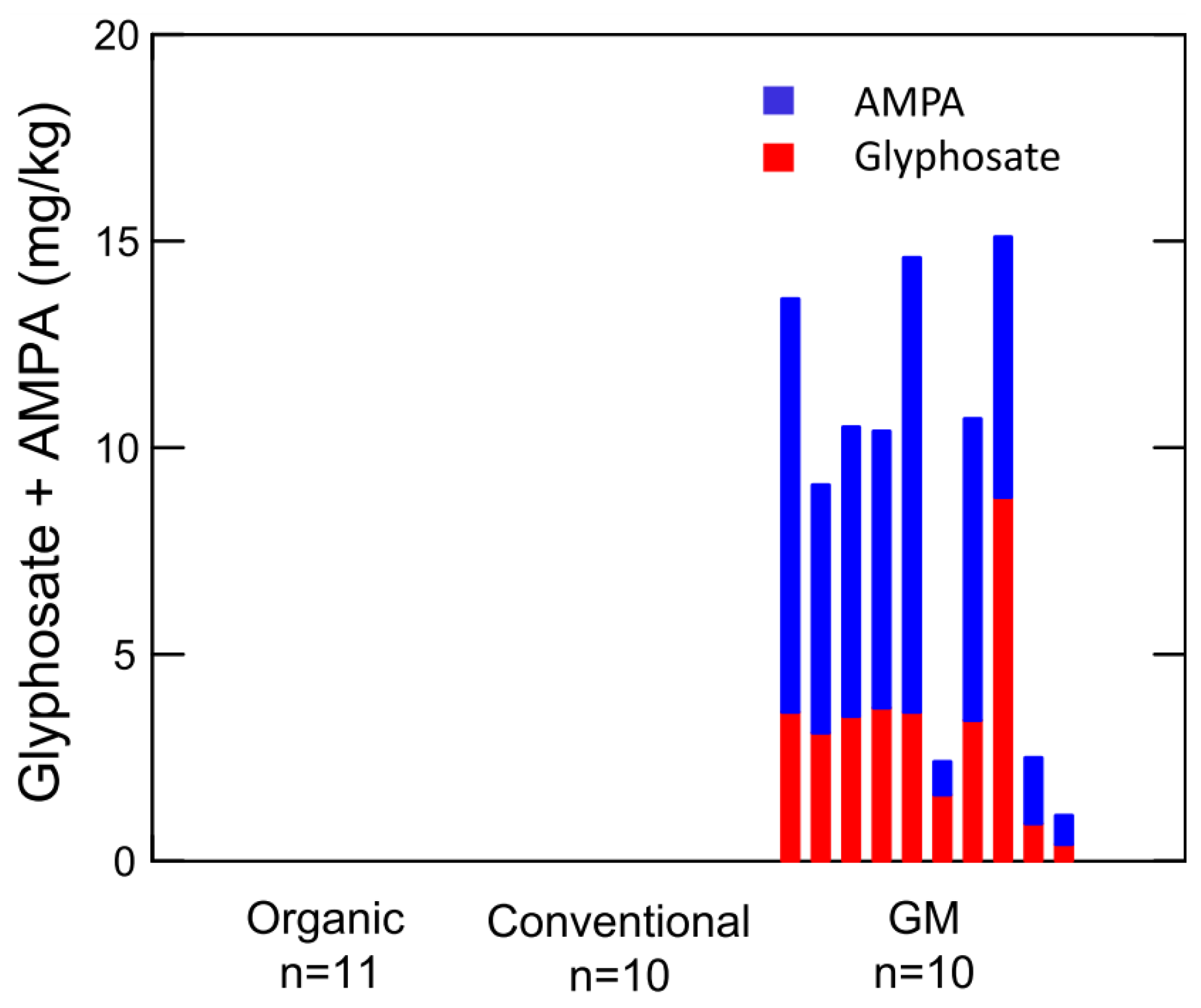

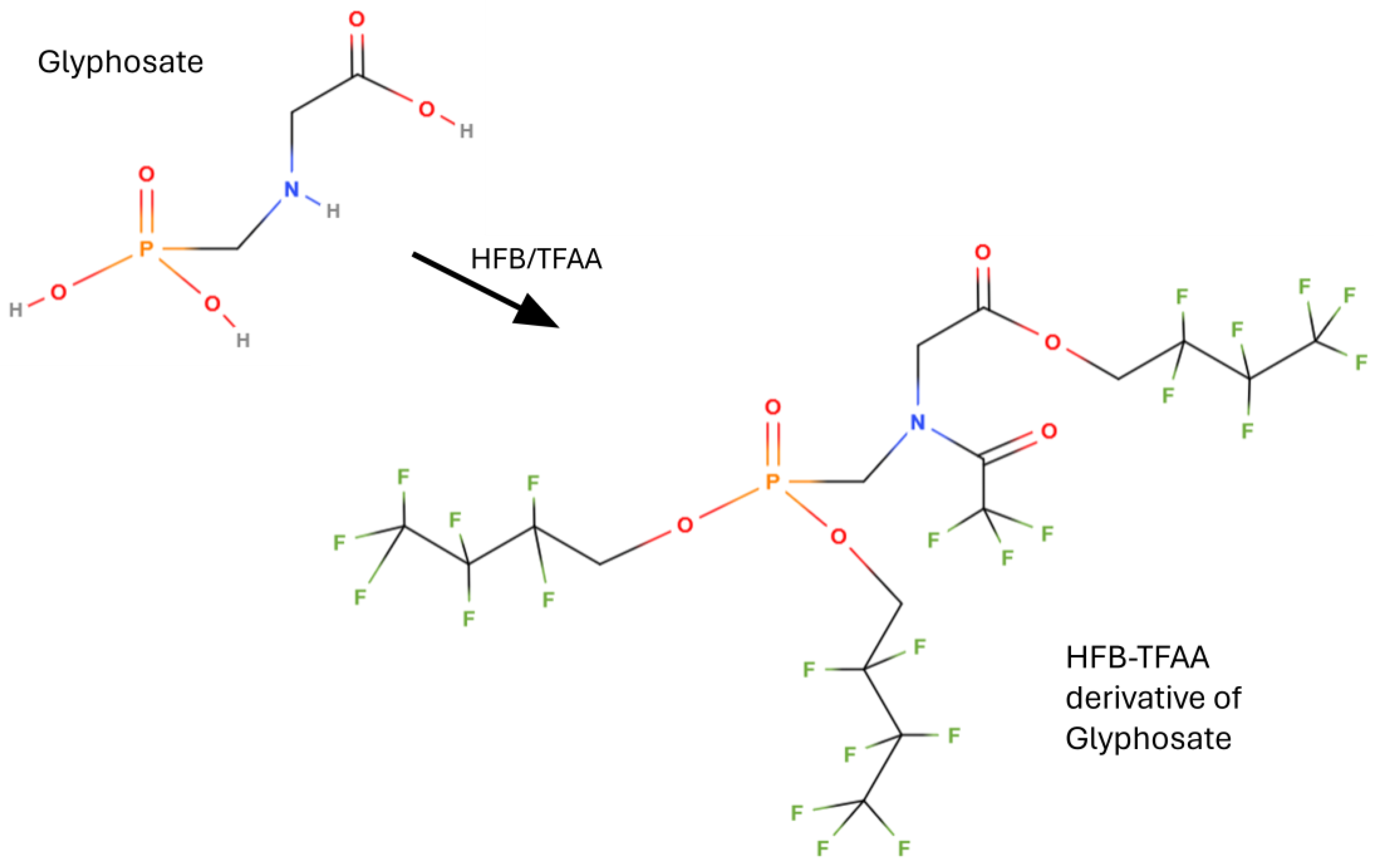
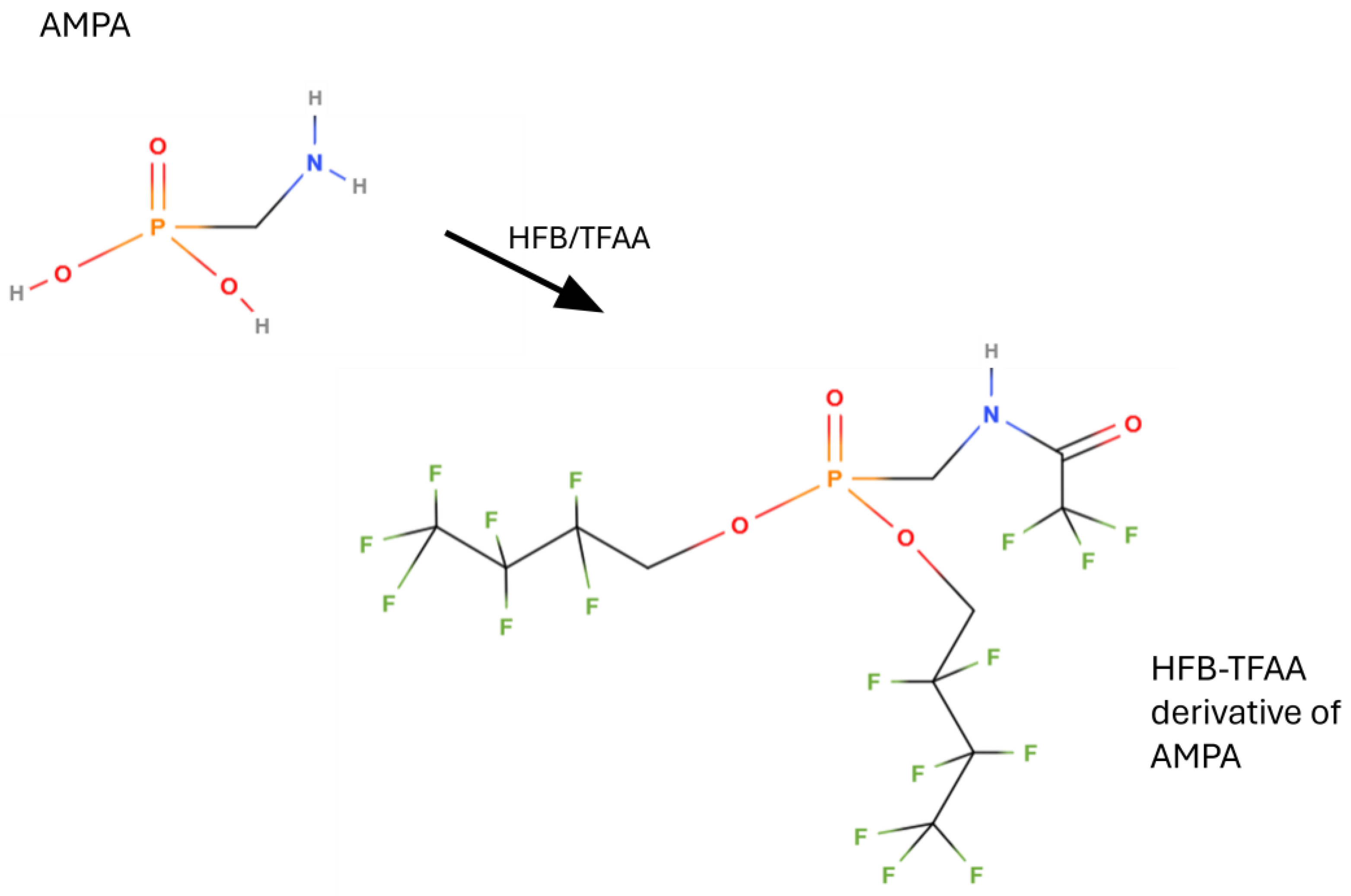
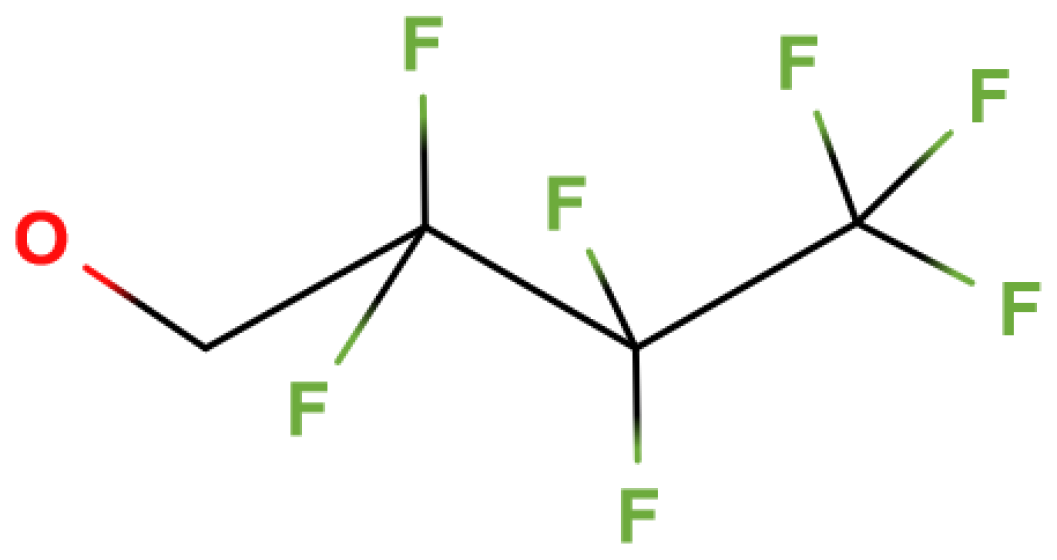
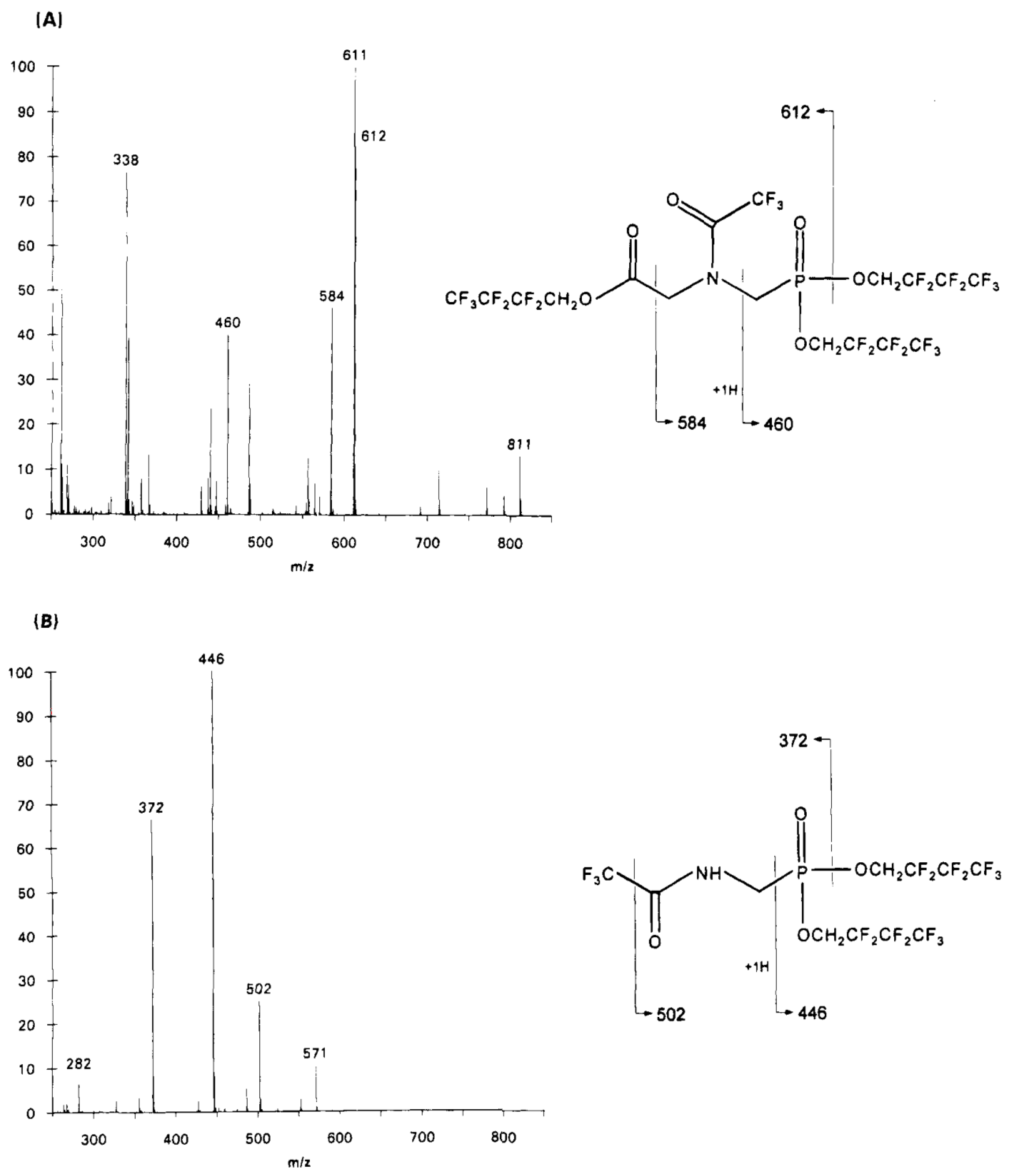

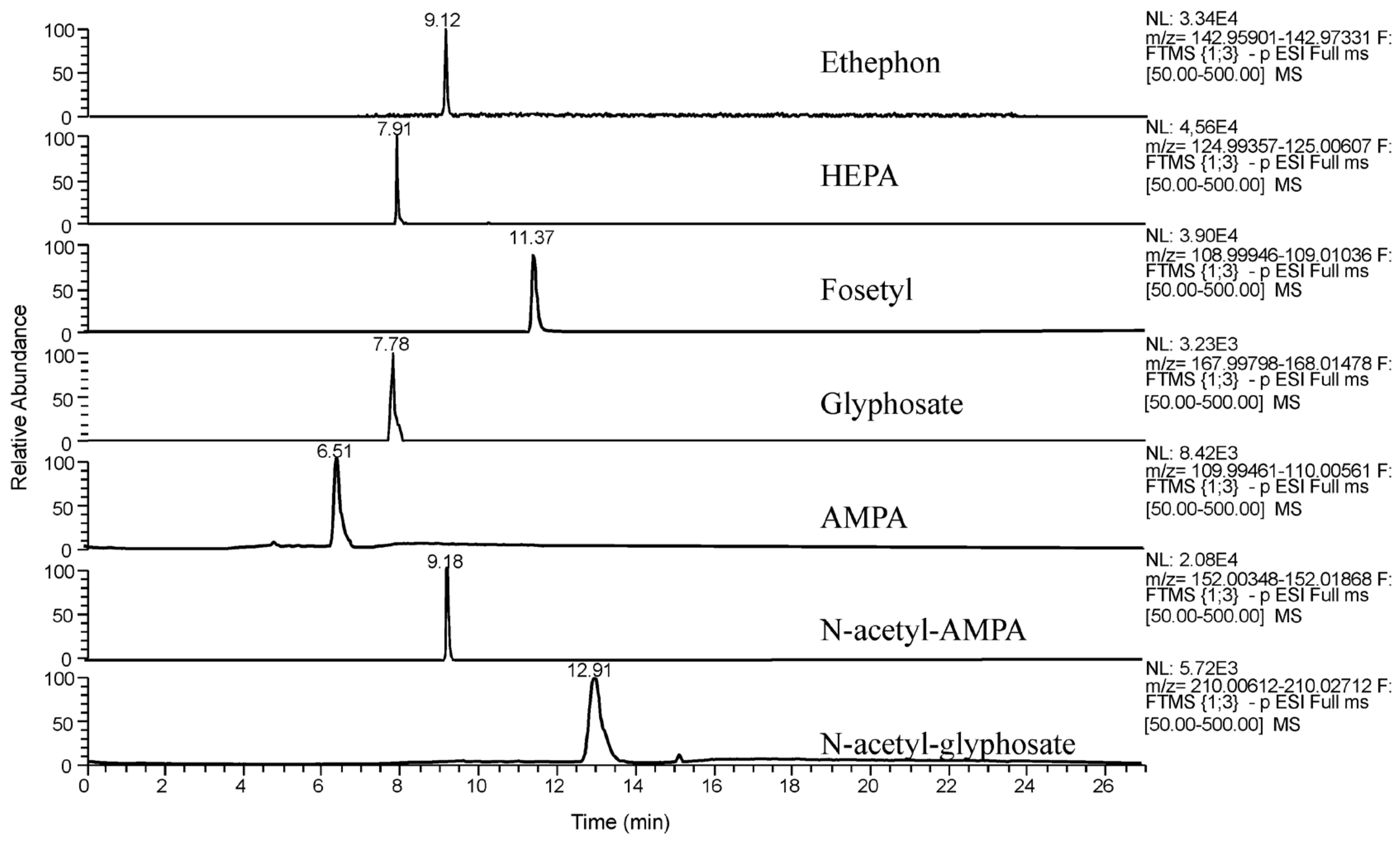
| Cereals and Cereal-Based Foods | Glyphosate Concentration (mg kg−1) | AMPA Concentration (mg kg−1) | Reference |
|---|---|---|---|
| Barley | <0.45 | n.a. 1 | [61] |
| Oats | <0.08 | n.a. 1 | [61] |
| Rye | <0.04 | n.a. 1 | [61] |
| Durum wheat | 0.421 (max.) | 0.0247 (max.) | [62] |
| Wheat | <0.13 | n.a. 1 | [61] |
| Wheat | 6.1–11.1 | n.a. 1 | [4] |
| Wheat bran | <0.7 | n.a. 1 | [61] |
| Wheat flour | 0.02 | n.a. 1 | [61] |
| Bread | 0.0458 (max.) | traces | [62] |
| Breakfast cereals | 0.291 (max.) | 0.01 (max.) | [62] |
| Flour and baking mixtures | 0.133 (max.) | traces | [62] |
| GM soybean | 0.4–8.8 | 0.7–10 | [13] |
| GM corn | 0.15 | 0.49 | [63] |
| Wheat | 0.373 | 0.034 | [5] |
| Barley | 2.15 | 0.041 | [5] |
| Whole grain | 0.0257 | n.a. 1 | [64] |
| White bread | 0.0149 | n.a. 1 | [64] |
| Soy-based infant formulas | 0.03–1.08 | 0.02–0.17 | [65] |
| GM soybean | 0.1–1.8 | 0.9 (max.) | [66] |
| Corn flour | 0.0052–0.3 2 | [67] | |
| Breakfast cereals | 0.006–0.034 | n.a. 1 | [68] |
| Wheat flour | <0.03 | n.a. 1 | [69] |
| Wheat bran | 1.62 (max.) | n.a. 1 | [70] |
| Cereals and Related Crops | European Union [93,94] | FAO/WHO Codex [94,95] | U.S. EPA 1 [96] | Health Canada [97] |
|---|---|---|---|---|
| Barley | 20 | 30 | 30 | 10 |
| Buckwheat | 0.1 | 30 | 30 | |
| Maize/corn grains | 1 | 5 | 5 | 3 |
| Millet | 0.1 | 30 | 30 | |
| Oats | 20 | 30 | 30 | 15 |
| Rice | 0.1 | 0.1 | ||
| Rye | 10 | 30 | 30 | |
| Sorghum | 20 | 30 | 30 | |
| Soya beans | 20 | 20 | 20 | 20 |
| Wheat | 10 | 30 | 30 | 5 |
Disclaimer/Publisher’s Note: The statements, opinions and data contained in all publications are solely those of the individual author(s) and contributor(s) and not of MDPI and/or the editor(s). MDPI and/or the editor(s) disclaim responsibility for any injury to people or property resulting from any ideas, methods, instructions or products referred to in the content. |
© 2024 by the authors. Licensee MDPI, Basel, Switzerland. This article is an open access article distributed under the terms and conditions of the Creative Commons Attribution (CC BY) license (https://creativecommons.org/licenses/by/4.0/).
Share and Cite
Masci, M.; Caproni, R.; Nevigato, T. Chromatographic Methods for the Determination of Glyphosate in Cereals Together with a Discussion of Its Occurrence, Accumulation, Fate, Degradation, and Regulatory Status. Methods Protoc. 2024, 7, 38. https://doi.org/10.3390/mps7030038
Masci M, Caproni R, Nevigato T. Chromatographic Methods for the Determination of Glyphosate in Cereals Together with a Discussion of Its Occurrence, Accumulation, Fate, Degradation, and Regulatory Status. Methods and Protocols. 2024; 7(3):38. https://doi.org/10.3390/mps7030038
Chicago/Turabian StyleMasci, Maurizio, Roberto Caproni, and Teresina Nevigato. 2024. "Chromatographic Methods for the Determination of Glyphosate in Cereals Together with a Discussion of Its Occurrence, Accumulation, Fate, Degradation, and Regulatory Status" Methods and Protocols 7, no. 3: 38. https://doi.org/10.3390/mps7030038






